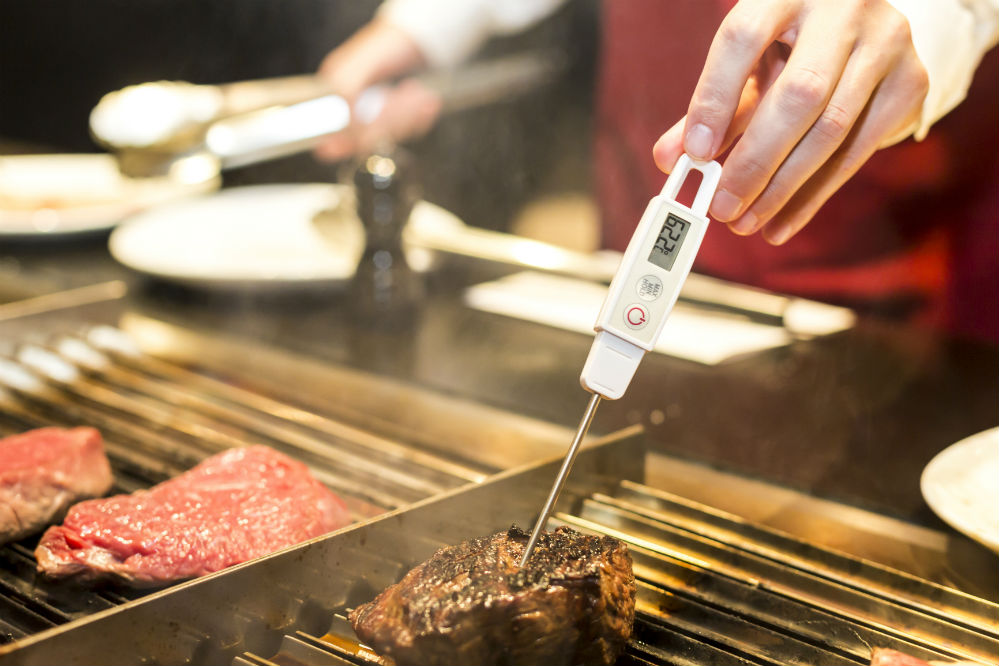This post contains affiliate links. As an Amazon Associate I earn from qualifying purchases
Proper food preparation and cooking facilitation are the two key things that any aspiring chef would need to learn to be successful, particularly when dealing with meat. Knowing how to use a meat thermometer also plays a key role, regardless if its chicken, beef, pork, or lamb.
Seasoning has always been related to taste, and as the taste buds of one’s tongue can be different from those of another, we can safely assume that the flavor is not the only criterion that make good food great. Sometimes, it’s how well the food is prepared, following the right process and methodologies, and how well it is cooked.
Other than experience, nothing can tell how well meat is cooked better than a meat thermometer, especially if you are working on thicker cuts of meat. This curious-looking device can give you the right temperature if it is well-calibrated and properly maintained.
Table of Contents
Benefits of Using Meat Thermometers
A basic meat thermometer is an indispensable tool around the kitchen, especially when you are cooking meat, baking bread or even if you are just frying foodstuff on the pan. This kitchen device has the following benefits:
- Prevents Illness
Bacteria are tough organisms to kill as they can survive harsh temperatures and extreme conditions. However, when it comes to foodborne bacteria, they can easily be killed by ensuring that the internal heat of the meat you are cooking has reached a certain temperature. This is where meat thermometers come in handy as they can give you that information by poking the meat just as it is about to reach the level of doneness that you so desire.
- Cooks More Accurately
Each cut and piece of meat can be cooked in the same way, but they can vary widely when it comes to their internal temperature and their cooking time. Methods that some cooks use to check the doneness of meat involve a lot of guessing and it’s not 100% accurate. A Meat thermometer eliminates this guesswork and provides you with accurate data that you can work with by taking the meat out immediately or by letting it sear some more.
- Makes Cooking Safer
Meat thermometers are not just used for cooking meat; they can also be used to monitor the temperature of baked goods, stews, and grills. These devices ensure that there is sufficient temperature to cook the food without allowing bacteria to breed and spread while cooking.
- Prevents Undercooking and Overcooking
Overcooked meat tends to come out as dry and tough while undercooked meat carries a funky smell and is harder to slice into. Meat thermometers ensure that the temperature inside the meat is just right, allowing it to stay juicy and tender.
Types of Meat Thermometers
There are many different kinds of meat thermometers on the market right now, ranging from analog to digital. Each has its advantages and disadvantages, which are entirely based on user preference. Here are some of the more common types of meat thermometers:
- Basic Meat Thermometers
The most common meat thermometer is the meat probe that lets you stick the sensor into the cut of meat and then read the temperature off of it. The display is your standard dial that can be calibrated by using a wrench or a pair of pliers. It can also come in the following variants.
- Oven-proof: These thermometers can be placed inside the oven together with the meat so that you can read the temperature even while it is still cooking.
- Timer-equipped: These thermometers come with a timer that can notify you once the meat reaches a certain temperature, or once a certain period has passed. This is great for stews and slow-cooked meals. It’s also great if you frequently need to step away from the kitchen or grilling area.
- Fork: As it is called, these thermometers resemble giants forks that can be used to hold meat as you slice it. This is ideal for grilling and for serving meat as you cook it.
- Digital Thermometers
Unlike the analog readouts, digital thermometers use microchips and simple programs that let you program it for certain cuts so that it will tell you if the temperature has reached a certain level. These are more expensive than analog thermometers, given the number of features that it has. We checked out a few of these and have reviewed them for you in a bit more depth. You can read about them here.
- Infrared Gun Thermometer
A new player in the meat thermometer game, infrared meat thermometers allow you to use infrared technology to determine the internal temperature of any cut of meat without having to poke the meat as you cook it. This is the most expensive meat thermometer, but it guarantees that the measurement is accurate, and it also brings the danger of food contamination via meat thermometers to zero.
How to Use a Meat Thermometer
For a kitchen device, meat thermometers are not complicated. You just need to know how to use a meat thermometer effectively for you to master it. Digital meat thermometers and infrared guns are pretty much straightforward with the way you use them. They often come with instruction manuals as well. Focused on manual meat thermometers, here is how you can use it more effectively, or at least properly.
Step 1: Make sure that the meat thermometer you will use has been cleaned and sanitized beforehand. This prevents the spread of bacteria and other forms of illness carrying organisms.
Step 2: Insert the probe or sensor into the thickest part of the meat. If you are using it for a stew or meat cut that has an even thickness, then make sure to check in at least three different sections to get an even reading.
Step 3: Wait for about 15 seconds for the temperature readout to stabilize. Follow the guide below for the proper cooking times for specific cuts and kinds of meat.
- Poultry: 165 degrees Fahrenheit or 70 degrees Celsius regardless of the doneness
- Pork: 145 degrees Fahrenheit for medium-rare and 160 degrees Fahrenheit for well-done
- Lamb: 130 degrees Fahrenheit for medium-rare, 150 degrees Fahrenheit for medium-well, and 155 degrees Fahrenheit for well-done
- Beef: 115 degrees Fahrenheit for rare, 130 degrees Fahrenheit for medium-rare, 140 degrees Fahrenheit for medium, 150 degrees Fahrenheit for medium-well, and 155 degrees Fahrenheit for well-done.
Caring for Your Meat Thermometer
Like any other tools or gadgets, caring for your meat thermometer is also a must. Below are some tips on how to make it lasts.
- Calibrate your meat thermometers every other month to ensure that you get the correct reading every time you use it. The frequency can change depending on how often you use your thermometers and how often it becomes inconsistent.
- Make it a habit to clean and sanitize your meat thermometer after every use.
- Store in a safe and dry place if it’s not in use to avoid any accidents.
Final Thoughts
Meat thermometers can be considered an important kitchen device as it helps prevent illnesses, and it also ensures that any meat you prepare is cooked through and through. There are other, albeit more basic, ways to tell if the meat is done or not, but a meat thermometer tells it more accurately, and you don’t run the risk of getting burnt or scalded by touching hot meat.


